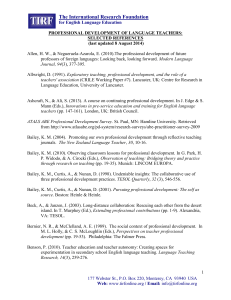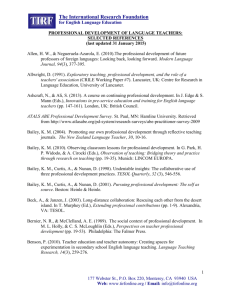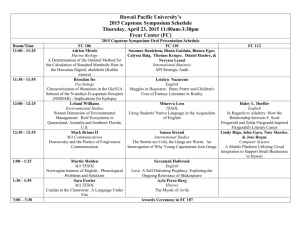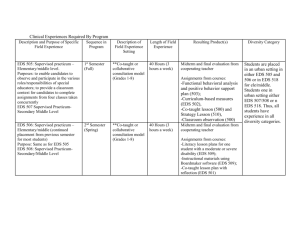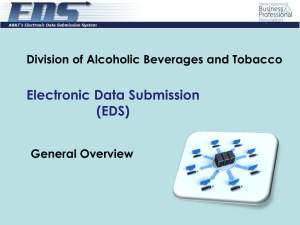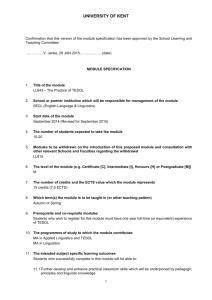Professional Development of Language Teachers
advertisement
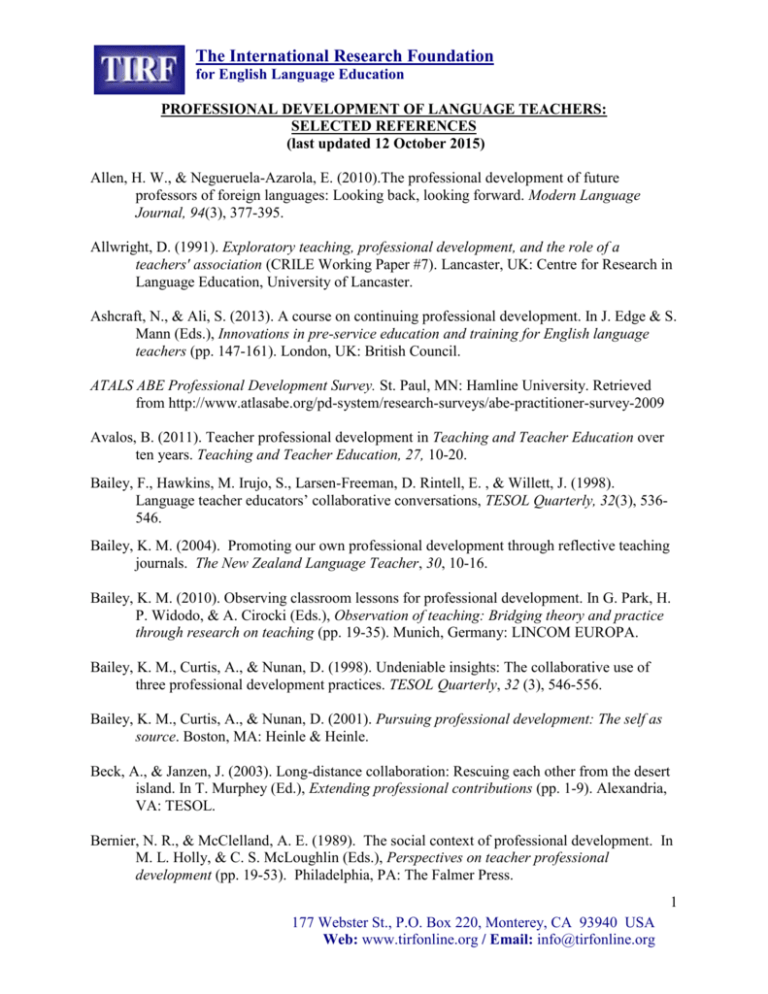
The International Research Foundation for English Language Education PROFESSIONAL DEVELOPMENT OF LANGUAGE TEACHERS: SELECTED REFERENCES (last updated 12 October 2015) Allen, H. W., & Negueruela-Azarola, E. (2010).The professional development of future professors of foreign languages: Looking back, looking forward. Modern Language Journal, 94(3), 377-395. Allwright, D. (1991). Exploratory teaching, professional development, and the role of a teachers' association (CRILE Working Paper #7). Lancaster, UK: Centre for Research in Language Education, University of Lancaster. Ashcraft, N., & Ali, S. (2013). A course on continuing professional development. In J. Edge & S. Mann (Eds.), Innovations in pre-service education and training for English language teachers (pp. 147-161). London, UK: British Council. ATALS ABE Professional Development Survey. St. Paul, MN: Hamline University. Retrieved from http://www.atlasabe.org/pd-system/research-surveys/abe-practitioner-survey-2009 Avalos, B. (2011). Teacher professional development in Teaching and Teacher Education over ten years. Teaching and Teacher Education, 27, 10-20. Bailey, F., Hawkins, M. Irujo, S., Larsen-Freeman, D. Rintell, E. , & Willett, J. (1998). Language teacher educators’ collaborative conversations, TESOL Quarterly, 32(3), 536546. Bailey, K. M. (2004). Promoting our own professional development through reflective teaching journals. The New Zealand Language Teacher, 30, 10-16. Bailey, K. M. (2010). Observing classroom lessons for professional development. In G. Park, H. P. Widodo, & A. Cirocki (Eds.), Observation of teaching: Bridging theory and practice through research on teaching (pp. 19-35). Munich, Germany: LINCOM EUROPA. Bailey, K. M., Curtis, A., & Nunan, D. (1998). Undeniable insights: The collaborative use of three professional development practices. TESOL Quarterly, 32 (3), 546-556. Bailey, K. M., Curtis, A., & Nunan, D. (2001). Pursuing professional development: The self as source. Boston, MA: Heinle & Heinle. Beck, A., & Janzen, J. (2003). Long-distance collaboration: Rescuing each other from the desert island. In T. Murphey (Ed.), Extending professional contributions (pp. 1-9). Alexandria, VA: TESOL. Bernier, N. R., & McClelland, A. E. (1989). The social context of professional development. In M. L. Holly, & C. S. McLoughlin (Eds.), Perspectives on teacher professional development (pp. 19-53). Philadelphia, PA: The Falmer Press. 1 177 Webster St., P.O. Box 220, Monterey, CA 93940 USA Web: www.tirfonline.org / Email: info@tirfonline.org The International Research Foundation for English Language Education Benson, P. (2010). Teacher education and teacher autonomy: Creating spaces for experimentation in secondary school English language teaching. Language Teaching Research, 14(3), 259-276. Bigelow, M., Wesley, P., & Opsahl, L. (2009). Multicultural education in a K-12 modern language department: Reconciling the professional development experience. International Journal of Multicultural Education, 11(2), 1-17. http://ijmejournal.org/index.php/ijme Borg, S. (2003). Pulp fiction? The research journal and professional development. In T. Murphey (Ed.), Extending professional contributions (pp. 39-46). Alexandria, VA: TESOL. Borg, S. (2006). Classroom research as professional development. In Borg, S. (eds.), Classroom Research in ELT in Oman. Muscat: Ministry of Education, Sultanate of Oman. Brannan, D., & Bleistein, T. (2012). Novice ESOL teachers' perceptions of social support networks. TESOL Quarterly,46(3), 519-541. Breen, M. P. (2007). Appropriating uncertainty: EFL Professional development in the new century. In J. Cummins & C. Davison (Eds.), International handbook of English language teaching (pp. 1-19). New York, NY: Springer. Blackman, C. A. (1989). Issues in professional development: The continuing agenda. In M. L. Holly, & C. S. McLoughlin (Eds.), Perspectives on teacher professional development (pp. 1-15). Philadelphia, PA: The Falmer Press. Bullough, R. V., & Stokes, D. K. (1994). Analyzing personal teaching metaphors in pre-service teacher education as a means for encouraging professional development. American Education Research Journal, 31(1), 197-224. Borg, S. (1998). Data-based teacher development. English Language Teaching Journal, (52)4, 273-281. Borg, S. (2011). The impact of in-service teacher education on language teachers’ beliefs. System, 39(3), 370-380. Borg, S. (2013). Teacher research in language teaching: A critical analysis. Cambridge, UK: Cambridge University Press. Borg, S., & Liu, Y. (2013). Chinese college English teachers’ research engagement. TESOL Quarterly, 47(2), 270-299. Borko, H. (2004). Professional development and teacher learning: Mapping the terrain. Educational researcher, 33(8), 3– 15. 2 177 Webster St., P.O. Box 220, Monterey, CA 93940 USA Web: www.tirfonline.org / Email: info@tirfonline.org The International Research Foundation for English Language Education Cajkler, W., & Hall, B. (2012). Languages in primary classrooms: A study of new teacher capability and practice. Language Awareness, 21(1-2), 15-32. Childs, S. (2010). “Seeing” L2 teacher learning: The power of context on conceptualizing teaching. In K. E. Johnson & P. Golombek (Eds.), Research on second language teacher education: Exploring the complexities of professional development (pp. 67-85). New York, NY: Routledge. Clandinin, D. J., & Connelly, F. M. (1995). Teachers' professional knowledge landscapes. New York, NY: Teachers College Press. Clarke, A. (1995). Professional development in practicum settings: Reflective practice under scrutiny. Teaching and Teacher Education, 11(4), 243-261. Clarke, D., & Hollingsworth, H. (2002). Elaborating a model of teacher professional growth. Teaching and Teacher Education, 18, 947-967. Coady, M., Harper, C., & de Jong, E. (2011). From preservice to practice : Mainstream elementary teacher beliefs of preparation and efficacy with English language learners in the state of Florida. Bilingual Research Journal, 34(2), 223-239. Cole, A. L., & Knowles, J. G. (2000). Researching teaching: Exploring teacher development through reflexive inquiry. Needham Heights, MA: Allyn & Bacon. Coles, P., & Quirke, P. (2001). Professional development through the action learning gateway. ThaiTESOL Newsletter, 14, 14-20. Crandall, J. A., & Finn Miller, S. (2014). Effective professional development for language teachers. In M. Celce-Murcia, D. M. Brinton, & M. A. Snow (Eds.) Teaching English as a second or foreign language. 4th ed. (pp. 630-648). Boston, MA: National Geographic Learning/Cengage Learning. Curtis, A. (2006). Weighing the why and why nots of professional development. Essential Teacher, 3(1). 14-15. Curtis, A. (2008). Seven principles of professional development: From A to G. In C. Coombe, M. L. McCloskey, L. Stephenson, & N. Anderson (Eds.), Leadership in English language teaching and learning (pp. 117-127). Ann Arbor, MI: University of Michigan Press. Dar, W. A. (2005). Initiating research in teacher development. SPELT Quarterly, 20(4), 3-37. Darling-Hammond, L. (1998). Teacher learning that supports student learning [Electronic version]. Educational Leadership, 55, 6-11. Retrieved from http://www.ascd.org/publications/educational_leadership/feb98/vol55/num05/Teacher_L earning_That_Supports_Student_Learning.aspx 3 177 Webster St., P.O. Box 220, Monterey, CA 93940 USA Web: www.tirfonline.org / Email: info@tirfonline.org The International Research Foundation for English Language Education Darling-Hammond, L., & McLaughlin, M. W. (1995). Policies that support professional development in an era of reform. [electronic version] Phi Delta Kappan, 28. Desimone, L. M. (2009). Improving impact studies of teachers’ professional development: Toward better conceptualizations and measures. Educational Researcher, 38(3), 181–199. Dubetz, N. E. (2005). Improving ESL instruction in a bilingual program through collaborative, inquiry-based professional development. In D. J. Tedick (Ed.), Second language teacher education: International perspectives (pp. 231-255). Mahwah, NJ: Lawrence Erlbaum Associates. Duke, D. L. 1990. Setting goals for professional development. Educational Leadership, 47(8), 71-75. Duune, F., Nave, B., & Lewis, A. (2000). Critical friends groups: Teachers helping teachers to improve student learning. Phi Delta Kappa Research Bulletin, 28(4), 9-12. Edelfelt, R. A. (1989). Teacher organization influence on professional development. In M. L. Holly & C. S. McLoughlin (Eds.), Perspectives on teacher professional development (pp. 207-218). Philadelphia, PA: The Falmer Press. Edge, J. (1992). Cooperative development: Professional self-development through cooperation with colleagues. London, UK: Longman. Edge, J. 1992. Co-operative development. ELT Journal, 46(1), 62-70. Edge, J. (1993). Cooperative development: Professional self-development through cooperation with colleagues. London, UK: Longman. Edge, J. (2002). Continuing cooperative development: A discourse framework for individuals as colleagues. Ann Arbor, MI: University of Michigan Press. Eraut, M. (1994). Developing professional knowledge and competence. Philadelphia, PA: Falmer Press. Faez, F., & Valeo, A. (2012). TESOL teacher education: Novice teachers' perceptions of their preparedness and efficacy in the classroom. TESOL Quarterly, 46(3), 450-471. Farrell, T. S. C. (2010). Professional development through reflective practice IN and FOR action. In G. Park, H. P. Widodo, & A. Cirocki (Eds.), Observation of teaching: Bridging theory and practice through research on teaching (pp. 37-47). Munich: LINCOM EUROPA. 4 177 Webster St., P.O. Box 220, Monterey, CA 93940 USA Web: www.tirfonline.org / Email: info@tirfonline.org The International Research Foundation for English Language Education Field, M. L., & Nagai, N. (2003). The "Dead Hand" Project: Intercultural collaboration and professional development. In T. Murphey (Ed.), Extending professional contributions (pp. 11-18). Alexandria, VA: TESOL. Finocchiaro, M. (1988). Teacher development: A continuing process. English Teaching Forum, 26, 2-5. Fowle, C, & Durham, J. (2001, April/May). Stories of professional development in Thailand and Laos. IATEFL, 160, 12-13. Freeman, D. (1982). Observing teachers: Three approaches to in-service training and development. TESOL Quarterly, 16(1), 21-28. Freeman, D. (1989). Teacher training, development, and decision making: A model of teaching and related strategies for language teacher education. TESOL Quarterly, 23(1), 27-45. Fullan, M.G. (1995). The limits and the potential of professional development. In T. R. Guskey & M. Huberman (Eds.), Professional development in education: New paradigms and practices (pp. 253-267). New York, NY: Teachers College Press. Gao, X., & Benson, P. (2012). 'Unruly pupils' in pre-service English language teachers' teaching practicum experiences. Journal of Education For Teaching, 38(2), 127-140. Gebhard, J. G. (1996). Teaching English as a foreign language: A teacher self-development and methodology guide. Ann Arbor, MI: The University of Michigan Press. Gebhard, G., & Oprandy, R. (1999). Language teaching awareness: A guide to exploring beliefs and practices. Cambridge, UK: Cambridge University Press. Gebhard, M. (1998). A case for professional development schools. TESOL Quarterly, 32(4), 501-510. Golombek, P., & Doran, M. (2014). Unifying cognition, emotion, and activity in language teacher professional development. Teaching and Teacher Education, 39, 102-111. Gorsuch, G., & Beglar, D. (2003). Fostering graduate school teacher development through peer interviewing. In T. Murphey (Ed.), Extending professional contributions (pp. 29-37). Alexandria, VA: TESOL. Griffee, D. (1988). Interview: Donald Freeman. The Language Teacher, 12, 21-28. Grimmet, P., & Neufeld, J. (Eds.). (1994). Teacher development and the struggle for authenticity. New York, NY: Teachers College Press. 5 177 Webster St., P.O. Box 220, Monterey, CA 93940 USA Web: www.tirfonline.org / Email: info@tirfonline.org The International Research Foundation for English Language Education Grossman, P. L. 1992. Why models matter: An alternative view on professional growth in teaching. Review of Educational Research, 62(2), 171-179. Grundy, P. (Ed.). (1998). Manchester Conference selections. Whitstable, Kent, UK: IATEFL. Guskey, T. (1995). Professional development in education: In search of the optimal mix. In T.R Guskey & M. Huberman (Eds.), Professional development education: New paradigms and practices (pp. 114-131). New York, NY: Teachers College Press. Guskey, T. R. (1997). Research needs to link professional development and student learning. Journal of Staff Development, 18(20), 36-41. Haberman, M. (1989). The influence of competing cultures on teacher development. In M. L. Holly & C. S. McLoughlin (Eds.), Perspectives on teacher professional development (pp. 55-75). Philadelphia, PA: The Falmer Press. Head, K., & Taylor, P. (1997). Readings in teacher development. Oxford, UK: Heinemann. Hiver, P. (2013). The interplay of possible language teacher selves in professional development choices. Language Teaching Research, 17(2), 210-227. Holly, M. L., & McLoughlin, C. S. (Eds.). (1989). Perspectives on teacher professional development. Philadelphia, PA: The Falmer Press. Holly, M. L. H. & Mcloughlin, C. S. 1989. Professional development and journal writing. In M. L. H. Holly & C. S. McLoughlin (Eds.), Perspectives on teacher professional development (pp. 259-283). London, UK: Falmer Press. Hord, S. M. (1997). Professional learning communities: What are they and why are they important? [Electronic version]. Issue . . . About Change, 6(1). Retrieved from www.sedl.org/change/issues/issues61.html Hulbert-Holly, M. L. (1989). Teacher professional development: Perceptions and practices in the USA and England. In M. L. Holly & C. S. McLoughlin (Eds.), Perspectives on teacher professional development (pp. 173-203). Philadelphia, PA: The Falmer Press. Hulbert-Holly, M. L., & McLoughlin, C. S. (1989). Professional development and journal writing. In M. L. Holly & C. S. McLoughlin (Eds.), Perspectives on teacher professional development (pp. 259-283). Philadelphia, PA: The Falmer Press. Hyde, P. (2000). Toward a virtual learning community: Building a professional development website for the AMEP. Prospect, 15, 65-80. Ingvarson, L. (1998). Teaching standards: foundations for professional development reform. In A. Hargreaves, A. Lieberman, M. Fullan, & D. Hopskins (Eds.). International handbook of educational change (pp. 336-361). Dordecht: Kluwer. 6 177 Webster St., P.O. Box 220, Monterey, CA 93940 USA Web: www.tirfonline.org / Email: info@tirfonline.org The International Research Foundation for English Language Education Jaramillo, A. (1998). Professional development from the inside out. TESOL Journal, 7, 12-18. Jiménez Raya, M. (2009). On inquiry, action and identity in professional development towards pedagogy for autonomy. In F. Vieira (Ed.), Struggling for autonomy in language education. Reflecting, acting, and being (pp. 187-195). Frankfurt am Main: Peter Lang. Johnson, K. E., & Golombek, P. R. (2002). (Eds.). Teachers’ narrative inquiry as professional development. Cambridge, UK: Cambridge University Press. Johnson, K. E., & Golombek, P. R. (Eds.). (2011). Research on second language teacher education London, UK: Routledge. Johnston, B., Pawan, F., & Mahan-Taylor, R. (2005). The professional development of working ESL/EFL teachers: A pilot study. In D. J. Tedick (Ed.), Second language teacher education: International perspectives (pp. 53-72). Mahwah, NJ: Lawrence Erlbaum Associates. Kagan, D. M. (1992). Professional growth among preservice and beginning teachers. Review of Educational Research, 62, 129-169. Kaufman, D. (2000). Developing professionals: Interwoven visions and partnerships. In K. E. Johnson (Ed.), Teacher education (pp. 51-69). Alexandria, VA: TESOL. Kubanyiova, M. (2012). Teacher development in action: Understanding language teachers' conceptual change. Basingstoke, UK: Palgrave Macmillan Kawachi, P. (2000). Listening to other teachers – the professional development of university teachers: Case study at a Japanese national university. Staff and Educational Development International, 4, 65-82. Knapp, M. S. (2004). Professional development as a policy pathway. In R. E. Floden (Ed.), Review of research in education, 27 (pp. 109-157). Washington, DC: AERA. Korthagen, F. J. J., & Vasalos, A. (2005) Levels in reflection: Core reflection as a means to enhance professional development. Teachers and Teaching: Theory and Practice, 11(1), 47-71. Kourieos, S. (2014). The knowledge base of primary EFL teachers - pre-service and in-service teachers' perceptions. Journal of Language Teaching and Research, 5(2), 291-300. Kubanyiova, M. (2012). Teacher development in action: Understanding language teachers' conceptual change. Basingstoke, UK: Palgrave Macmillan. 7 177 Webster St., P.O. Box 220, Monterey, CA 93940 USA Web: www.tirfonline.org / Email: info@tirfonline.org The International Research Foundation for English Language Education Lange, D. L. (1990). A blueprint for a teacher education program. In J. C. Richards & D. Nunan (Eds.), Second language teacher education (pp. 245-268). Cambridge, UK: Cambridge University Press. Leland, A. O., Cooper, J. H., & Harder, H. L. (1984). Teacher development: Learning experience framework for teacher candidates. Teacher Education Quarterly, 11, 115-125. Leung, C. (2009). Second language teacher professionalism. In A. Burns & J. C. Richards (Eds.), Second language teacher education (pp. 49-58). New York, NY: Cambridge University Press. Liebermann, A., & Miller, L. (1992). Professional development of teachers. In Encyclopedia of Educational Research (6th ed., Vol. 3) (pp. 1045-1053). New York, NY: McMillan Publishing Company. Little, J. W. (1984). Seductive images and organizational realities in professional development. Teachers College Board, 86(1), 84-102. Little, J. W. (2007). Teachers’ accounts of classroom experience as a resource for professional learning and instructional decision making. In P. A. Moss (Ed.), Evidence and decision making (pp. 217-240). Oxford, UK: Wiley-Blackwell. Lockhart, C. (1990). Co-operative teacher development: New observations on observation. Perspectives: Working Papers of the Department of English, City Polytechnic of Hong Kong, 2, 43-57. Lyons, N. (1990). Dilemmas of knowing: Ethical and epistemological dimensions of teachers' work and development. Harvard Educational Review, 60, 159-180. Mak, S. H. (2011). Tensions between conflicting beliefs of an EFL teacher in teaching practice. RELC Journal, 42(1), 53-67. Mann, S. (2005). The language teachers’ development. Language Teaching, 38(3), 103-118. Mawhinney, L. (2010). It’s not you, it’s me: A teacher’s reflection of self-discovery through Delpit’s Culture of Power theory. In G. Park, H. P. Widodo, & A. Cirocki (Eds.), Observation of teaching: Bridging theory and practice through research on teaching (pp. 99-108). Munich, Germany: LINCOM EUROPA. McAlpine, D., Cheatham, R., Dhonau, S., & Lytle, A. (2007). The reality of foreign language professional development for K-12 teachers. ADFL Bulletin, 38 and 39, 40-46. Middlehurst, R., & Kennie, T. (1997). Leading professionals: Towards new concepts of professionalism. In J. Broadbent, M .Dietrich, & J. Roberts (Eds.), The end of the professions? (pp. 50-68). London, UK: Routledge. 8 177 Webster St., P.O. Box 220, Monterey, CA 93940 USA Web: www.tirfonline.org / Email: info@tirfonline.org The International Research Foundation for English Language Education Moon, J. (1994). A collaborative model for professional development: Teachers, teacher trainees and college lecturers working together. In D. C. S. Li, D. Mahoney, & J. C. Richards (Eds.), Exploring second language teacher development (pp. 45-58). Hong Kong: City Polytechnic of Hong Kong. Moon, J. (1999). Reflection in learning and professional development: Theory and practice. London, UK: Kogan Page. Morton, T., & Gray, J. (2010). Personal practical knowledge and identity in lesson planning conferences on a preservice TESOL course. Language Teaching Research, 14(3), 297317. Murphey, T. (2000). Becoming contributing professionals: Nonnative-English-speakingteachers in an EFL environment. In K. E. Johnson (Ed.), Teacher education (pp. 105168). Alexandria, VA: TESOL. Murphey, T., Connolly, M., Churchill, E., McLaughlin, J., Schwartz, S. L., & Krajka, J. (2003). Creating publishing communities. In T. Murphey (Ed.), Extending professional contributions (pp. 105-118). Alexandria, VA: TESOL. Myers, M. (1984). The need for a new teacher professionalism. Teacher Education Quarterly, 11(3). Myers, M. (1993). To boldly go . . . In J. Edge & K. Richards (Eds.), Teachers develop teachers research: Papers on classroom research and teacher development. Oxford, UK: Heinemann. Neher, B. (2013). Facilitating change in ELT practice: How professional development can be enhanced by understanding change. In T. Pattison (Ed.), IATEFL 2012: Glasgow Conference Selections (pp. 219-221). Canterbury, UK: IATEFL. Nishino, T. (2012). Multi-membership in communities of practice: An EFL teacher’s professional development. TESL-EJ, 16(2). Nunan, D. (1989). Understanding language classrooms: A guide for teacher-initiated action New York, NY: Prentice Hall. Oliver, R. M., & Reschley, D. J. (2007). Effective classroom management: Teacher preparation and professional development (Issue paper). Washington, DC: National Comprehensive Center for Teacher Quality. Retrieved from http://www.tqsource.org/topics/effectiveClassroomManagement.pdf Orem, R. A. (1990). Theory, practice, research, and professionalization of the field of teaching English to speakers of other languages. In J. E. Alatis (Ed.), Linguistics, language teaching and language acquisition: The interdependence of theory, practice and research (pp. 338-344). Washington, DC: Georgetown University. 9 177 Webster St., P.O. Box 220, Monterey, CA 93940 USA Web: www.tirfonline.org / Email: info@tirfonline.org The International Research Foundation for English Language Education Pawan, F., & Jacobson, A. (2003). Growing with the flow: Sustaining professionalism through online instruction of language teachers. In T. Murphey (Ed.), Extending professional contributions (pp. 67-75). Alexandria, VA: TESOL. Pettis, J. (2002). Developing our professional competence: Some reflections. In J.C. Richards & W. A. Renandya (Eds.), Methodology in language teaching: An anthology of current practice (pp. 393-396). Cambridge, UK: Cambridge University Press. Polat, N., & Mahalingappa, L. (2013). Pre- and in-service teachers' beliefs about ELLs in content area classes: A case for inclusion, responsibility, and instructional support. Teaching Education, 24(1), 58-83. Reese, S. (2008). Teacher education: Growing the future of our profession. The Language Educator, 3, 22-26. Richards, K. (2002). Trust: A management perspective on CPD. In J. Edge (Ed.), Continuing professional development: Some of our perspectives (pp. 71-79). Whitstable, UK: IATEFL. Richards, J. C., & Farrell, T. S. C. (2005). Professional development for language teachers: Strategies for teacher learning. Cambridge, UK: Cambridge University Press. Roberts, J. (1998). Language teacher education. London, UK: Arnold. Rueda, R. (1998, December). Standards for professional development: A sociocultural perspective (Research Brief No. 2). Center for Research on Education, Diversity & Excellence. Retrieved from http://gse.berkeley.edu/research/credearchive/research/pted/rb2.shtml Sachs, J. (2003). Teacher professional standards: Controlling or developing teaching? Teachers and Teaching: theory and practice, 9(2), 175-186. Sato, K. (2003). Starting a local teacher study group. In T. Murphey (Ed.), Extending professional contributions (pp. 97-104). Alexandria, VA: TESOL. Shimahara, N. K. (1998). The Japanese model of professional development: Teaching as craft. Teaching and Teacher Education, 14(5), 451-462. Showers, B., Joyce, B., & Bennett, B. (1987). Synthesis of research on staff development: A framework for future study and a state-of-the-art analysis. Educational Leadership, 45, 77-87. Smith, C., & Gillespie, M. (2007). Research on professional development and teacher change: Implications for adult basic education. Review of adult learning and literacy, 7, 205–244. 10 177 Webster St., P.O. Box 220, Monterey, CA 93940 USA Web: www.tirfonline.org / Email: info@tirfonline.org The International Research Foundation for English Language Education Smith, L. (2005). The impact of action research on teacher collaboration and professional growth. In D. J. Tedick (Ed.), Second language teacher education: International perspectives (pp. 199-213). Mahwah, NJ: Lawrence Erlbaum Associates. Smylie, M. A. (1995). Teacher learning in the workplace. In T. R. Guskey & M. Huberman (Eds.), Professional development in education (pp. 92-113). New York, NY: Teachers College. Steele, T. M., Peterson, M. D., Silva, D. M., & Padilla, A. M. (2009). A year-round professional development model for world language educators. Foreign Language Annals, 42, 195211. Stewart, T., & Lokon, E. (2003). Professional development through student and teacher reflection journals. In T. Murphey (Ed.), Extending professional contributions (pp. 1927). Alexandria, VA: TESOL. Tickle, J. H. (1989). New teachers and the development of professionalism. In M. L. Holly, & C. S. McLoughlin (Eds.), Perspectives on teacher professional development (pp. 93-115). Philadelphia, PA: The Falmer Press. Tsui, A. B. M. (2011). Teacher education and teacher development. In E. Hinkel (Ed.), Handbook of research in second language teaching and learning (Vol. 2, pp. 21-39), New York, NY: Routledge. Underhill, A. (1986). Training, development and teacher education. Teacher development Newsletter, 4, 9. Ur, P. (2002). The English teacher as professional. In J.C. Richards & W. A. Renandya (Eds.), Methodology in language teaching: An anthology of current practice (pp. 388-392). Cambridge, UK: Cambridge University Press. Varghese, M. (2001). Professional development as a site for the conceptualization and negotiation of bilingual teacher identities. In B. Johnston & S. Irujo (Eds.), Research and practice in language teacher education: Voices from the field (pp. 213-232). Minneapolis, MN: University of Minnesota, Center for Advanced Research in Second Language Acquisition. Vellenga, H. E. (2011). Teaching L2 pragmatics: Opportunities for continuing professional development. TESL-EJ, 15(2). Retrieved from http://www.teslej.org/wordpress/issues/volume15/ej58/ej58a3/ Vescio, V., Ross, D., & Adams, A. (2008). A review of research on the impact of professional learning communities on teaching practice and student learning. Teaching and Teacher Education, 24, 80-91. 11 177 Webster St., P.O. Box 220, Monterey, CA 93940 USA Web: www.tirfonline.org / Email: info@tirfonline.org The International Research Foundation for English Language Education Wadell, E., Frei, K., & Martin, S. (2012). Professional development through inquiry: Addressing sexual identity in TESOL. CATESOL Journal, 23, 99-109. Walker, R. (2003). Teacher development through communities of learning. In D.M. McInerney, & S. Van Etten (Eds.), Sociocultural influences and teacher education programs (pp. 223-246). Greenwich, CT: Information Age Publishing. Wan, W., Low, G. D., & Li, M. (2011). From students' and teachers' perspectives: Metaphor analysis of beliefs about EFL teachers' roles. System, 39(3), 403-415. Warschauer, M. (2006). Networking the Nile: Technology and professional development in Egypt. In J. Inman & B. Hewett (Eds.), Technology and English studies: Innovative professional paths (pp. 163-172). Mahwah, N.J.: Lawrence Erlbaum. Webster-Wright, A. (2009). Reframing professional development through understanding authentic professional learning. Review of Educational Research, 79(2), 702. Wigglesworth, G. (2000). Relating research and professional development: Assessment task design. Prospect, 15, 52-64. Williams, L., Abraham, L.B., & Bostelmann, E.D. (2014). A discourse-based approach to CALL training and professional development. Foreign Language Annals, 47(4), 614-629. Wright, T. (2009). “Trainer development”: Professional development for language teacher educators. In A. Burns, & J. C. Richards (Eds.), Second language teacher education (pp. 102-112). New York, NY: Cambridge University Press. Wu, Y. A. (2005). Aspiring after continued teacher development. Foreign Languages in China, 2, 13-20. Yayli, D. (2012). Professional language use by pre-service English as a foreign language teachers in a teaching certificate program. Teachers and Teaching: Theory and Practice, 18(1), 59-73. Yuan, R., & Lee, I. (2014). Pre-service teachers' changing beliefs in the teaching practicum: Three cases in an EFL context. System, 44(1), 1-12. 12 177 Webster St., P.O. Box 220, Monterey, CA 93940 USA Web: www.tirfonline.org / Email: info@tirfonline.org
